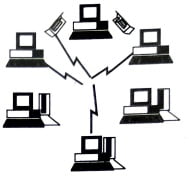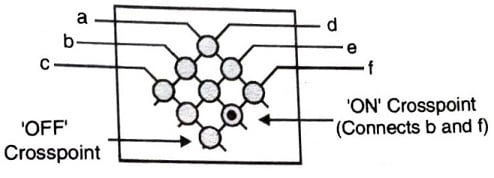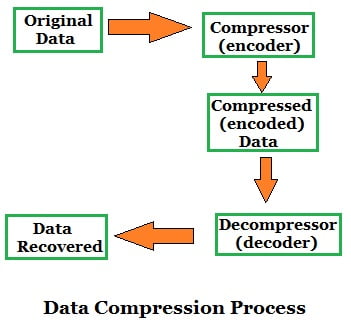Table of Contents
Wireless Local-Area Network (WLAN)
Wireless Local-Area Network (WLAN) is a technology that uses radiofrequency to transmit and receive data over the air, providing all the features and benefits of traditional LANs but without the limitations of a cable. It is a data communication system providing wireless peer-to-peer (PC-to-PC, PC-to-hub, or printer-to-hub) and point-to-point (LAN-to-LAN) connectivity within a building or campus. In place of TP or coaxial wires or optical fiber as used in a conventional LAN, WLANs transmit and receive data over electromagnetic waves. WLANs perform traditional network communication functions such as file transfer, peripheral sharing, e-mail, and database access as well as augmenting wired LANs.
Wireless Local-Area Network (WLAN) have gained strong popularity in a number of vertical markets, including health-care, retail, manufacturing, warehousing, and academia. These industries have profited from the WLAN’s productivity gains of using hand-held terminals and notebook computers to transmit real-time information. Today, WLANs are becoming more widely recognized as the connectivity alternative for a broad range of business customers.
Wireless LAN technology standard 802.11b has the strongest momentum to becoming the main standard for corporate internal wireless LAN networks. The bandwidth of 802.11b is 11 Mbps and operates at 2.4 GHz frequency. The successor of this current 802.11b standard is 802.11a and it is designed to be faster speed and operate at a different frequency. Its bandwidth is 54 Mbps. While 802.1la standard and the technology behind it has become available, 802.11b is still widely used today and many companies and individuals are deploying it or deploying dual 802.11b and 802.1la devices.
Wireless Local-Area Network (WLAN) Working
Wireless Local-Area Network (WLAN) uses electromagnetic airwaves (radio or infrared) to communicate information from one point to another without relying on any physical connection. Radio waves are often referred to as radio carriers because they simply perform the function of delivering energy to a remote receiver.
The data being transmitted is superimposed on the radio carrier so that it can be accurately extracted at the receiving end. This is generally referred to as modulation of the carrier by the information being transmitted. Once data is superimposed onto the radio carrier, the radio signal occupies more than a single frequency since the frequency or bit rate of the modulating information adds to the carrier. Multiple radio carriers can exist in the same space at the same time without interfering with each other if the radio waves are transmitted on different radio frequencies. To extract data, a radio receiver tunes in one radio frequency while rejecting all other frequencies.
In a typical wireless LAN configuration, a transmitter/receiver (transceiver) device, called an access point, connects to the wired network from a fixed location using standard cabling. At a minimum, the access point receives, buffers, and transmits data between the wireless LAN and the wired network infrastructure.
A single access point can support a small group of users and can function within a range of less than one hundred to several hundred feet. The access point (or the antenna attached to the access point) is usually mounted high but may be mounted essentially anywhere that is practical as long as the desired radio coverage is obtained. End users access the wireless LAN through wireless-LAN adapters, which are implemented as PC cards in notebook or palmtop computers, as cards in desktop computers, or integrated within hand-held computers. Wireless LAN adapters provide an interface between the client network operating system (NOS) and the airwaves via an antenna. The nature of the wireless connection is transparent to the NOS.
Wireless LAN Technology
A wide range of wireless technologies are available. Some may be listed as under :
Spread spectrum technology
Most wireless LAN systems use spread-spectrum technology, a wideband radio frequency technique developed by the military for use in reliable, secure, mission-critical communication systems. Spread-spectrum is designed to trade off bandwidth efficiency for reliability, integrity, and security. There are two types of spread spectrum radio: frequency hopping and direct sequence.
Narrowband Technology
A narrowband radio system transmits and-receives user information on a specific radio frequency. Narrowband radio keeps the radio signal frequency as narrow as possible just to pass the information. Undesirable crosstalk between communication channels is avoided by carefully coordinating different users on different channel frequencies.
Infrared Technology
The third technology, little used in commercial wireless LANs, is infrared. Infrared (IR) systems use very high frequencies, just below visible light in the electromagnetic spectrum, to carry data. Like light; IR cannot penetrate opaque objects; it is either directed (line-of-sight) or diffuse technology.
Wireless LAN Configuration
Wireless LAN is the latest example that uses wireless communication. It has been shown in the figure below. Devices such as workstations, Laptop, computers, cordless telephones and other communication appliances share the wireless medium such as 5 GHz radio or infrared light.

Wireless LAN Requirements
Some of the important requirements of a wireless LAN may be listed as under:
Throughput
The throughput capacity of the wireless LAN must be as high as possible. This is possible if the medium access control protocol is made as efficient as possible.
Number of Nodes
Usually, a few hundred nodes are required to be supported using the wireless LAN.
Connection to Backbone
LAN A wireless LAN in most of the cases is interconnected with a wired backbone LAN. The ad hoc LANs and mobile users must also be connected to the backbone LAN.
Service Area
A wireless LAN has a typical coverage area which range from 100 m to 300 m.
Longer Battery Life
The mobile users use battery power. In order to have a longer battery life, it is essential to minimize the battery power consumption.
Robustness and Security
Wireless LAN can be prone to interference. Hence, it must be properly designed to ensure reliable transmission even in a noisy atmosphere. Also, a minimum level of security must be provided from eaves dropping.
License-Free Operation
For the wide spread use of wireless LAN, it is essential to eliminate the requirement of license.
Allocated Network Operation
If two or more wireless LANs operate in the same area, then interference between them is Possible. This may result in malfunctioning of a MAC algorithm and may allow unauthorized access to a LAN.
Roaming Facility
A roaming facility must be provided to the mobile stations. When a mobile station moves from one cell to the other, they must remain in the network.
Problems Associated with Wireless Local-Area Network (WLAN)
we try to use CSMA for the wireless LAN, then it uses the principle of simply listening to other transmission and only transmit if no one else is transmitting. However, there are two problems in using CSMA. They are hidden station problem and exposed station problem.
Hidden Station Problem
Let us consider the figure is shown below, where station-1 is transmitting 1 to station-2. Now, if station-3 senses the medium to see if anyone is transmitting, it will not hear station 1 since it is out of range. Therefore station-3 will come to the wrong conclusion that no one is transmitting and so it can transmit to station-2. If station-3 starts transmitting, it will create interference at station-2 frames from station-1.
Fig. 15.12.

This problem in which a station is not able to detect a potential competitor which is too far away is known as the hidden station problem.
Exposed Station Problem
Now, let us consider the figure is shown below, in which station-2 is transmitting to station-1. If station-3 senses the medium, then since station-2 comes in range with station-3, so station-3 will sense the transmission going on. Therefore, it will falsely decide that it must not transmit to station-4. Here, it may be noted that the transmission from 3 to 4 is ok, even when 2 is transmitting. This problem is known as the exposed station problem.

Design Issues for Wireless Networks
Wireless networks make use of electromagnetic waves or infrared red light for communicating between two or more wireless devices. The data to be transmitted is superimposed on the radio carrier (modulation).
Some of the important issues that must be addressed while designing a wireless network may be listed as under:
Mobility
Wireless networks provide mobility to its users. They provide access to Internet and contact with the other users without using any wires.
Installation
Installing a wireless network is quite simple. It eliminates the requirement of pulling connecting wires.
Reliability
In wireless systems, the EM waves are used to carry the information. However, these waves undergo fading (loss of signals) because of various reasons. This shall lead to reduced reliability. Hence, some minimum level of reliability must be ensured.
Scalability
Wireless systems can be configured in different types of topologies depending upon the requirement of applications. It is possible to change the configuration easily right from peer to peer which is suitable for small networks to large infrastructural network used for large areas.
Wireless LAN: Advantages and Drawbacks
Advantages of Wireless Local-Area Network (WLAN)
There are a number of advantages of wireless LAN when compared with wired LAN, which may be described as under:
Easy Deployment
Adding new subscribers to existing WLAN facility does not involve making physical connections or running cables.
LAN Extension
The WLAN provides services to inaccessible areas by extending the wired LAN Internet connectivity.
Easy Access
To hook up to the existing network, the user just requires to enable the wireless device to access the available WLAN services as per the network configuration. Thus, there is no requirement of connecting any cable or finding the plug.
WLAN Mobility
The WLAN mobile users can access the network from any area where within the radio coverage of the network at any time. There is no line-of-sight requirement with the wireless access points till the received signal strength is good enough as the radio waves can penetrate the obstacles.
Cost Effective
After the initial cost of installation and commissioning of the network, there is no extra cost incurred in the infrastructure for providing services to additional WLAN users.
Smart Working
Senior executives can present their briefings using WLAN, without carrying the data files, charts, and any other storage material.
Increased Productivity
Wireless technologies have a direct impact or real-time increase in productivity due to minimum set-up requirements with centralized database access.
Drawbacks of Wireless Local-Area Network (WLAN)
There are certain drawbacks of wireless LAN as under:
Limited Bandwidth
Due to limited bandwidth and data-rate capability, the WLAN technology cannot support video teleconference or real-time applications. Also, the WLAN is not capable to download and upload large data files quickly.
Incompatibility
WLAN devices from different manufacturers are usually incompatible with each other as well as with other networks because of usage of a number of different standards.
Interference
The wireless link is not always reliable due to external noise and interference. The received signal strength may very significantly that may result in sudden disconnections or heavy errors.
Black or Dead Spots
Due to the type of surrounding structure (i.e., steel reinforcing materials) or high-power running machinery, there may be some spots where there is zero or very weak radio strength, thereby rendering the services inaccessible.
Less Security
Because of insecure wireless medium, the network is more vulnerable for malicious attacks and jamming.
Need of Backbone Network
Wireless transmission is slower, less efficient and less reliable compared to wired networks. The operation of WLAN is dependent on the reliable wired backbone network
Applications of Wireless LAN
There are four important applications of wireless LAN which may be listed as under:
- LAN extension
- Nomadic access
- Cross building interconnection
- Ad-hoc networks
Related Posts:



